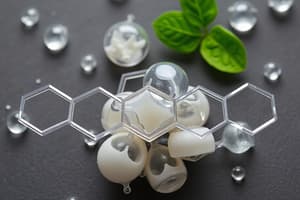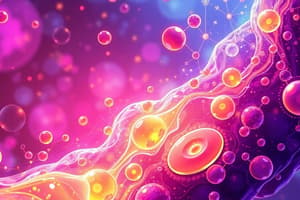Podcast
Questions and Answers
Which of the following is NOT one of the four basic groups of lipids?
Which of the following is NOT one of the four basic groups of lipids?
- Phospholipids
- Steroids (correct)
- Triglycerides
- Fatty acids
Which of the following is NOT a function of lipids?
Which of the following is NOT a function of lipids?
- Cellular communication
- Energy storage
- Protein synthesis (correct)
- Insulation
What are the common characteristics of fatty acids?
What are the common characteristics of fatty acids?
- They are synthesized in the liver
- They are composed of three fatty acids and a glycerol molecule
- They are insoluble in water (correct)
- They are the main components of cell membranes
What basic molecules constitute a triglyceride (TAG) molecule?
What basic molecules constitute a triglyceride (TAG) molecule?
What is the difference between LDL and HDL?
What is the difference between LDL and HDL?
Flashcards are hidden until you start studying
Study Notes
Lipid Groups and Functions
- Sterols, phospholipids, glycolipids, and fats are the four basic groups of lipids; proteins are NOT one of them.
- Lipids do not function as a catalyst for chemical reactions; they have various other functions such as energy storage, hormone regulation, and cellular structure.
Characteristics of Fatty Acids
- Fatty acids are characterized by having a hydrocarbon chain with a carboxyl group at one end, and they can be either saturated or unsaturated.
Triglyceride Molecule
- A triglyceride (TAG) molecule is composed of glycerol and three fatty acid chains.
LDL and HDL
- LDL (Low-Density Lipoprotein) is known as "bad" cholesterol, responsible for transporting cholesterol from the liver to peripheral tissues; it has a higher cholesterol content and lower protein content.
- HDL (High-Density Lipoprotein) is known as "good" cholesterol, responsible for transporting cholesterol from peripheral tissues to the liver; it has a higher protein content and lower cholesterol content.
Studying That Suits You
Use AI to generate personalized quizzes and flashcards to suit your learning preferences.




